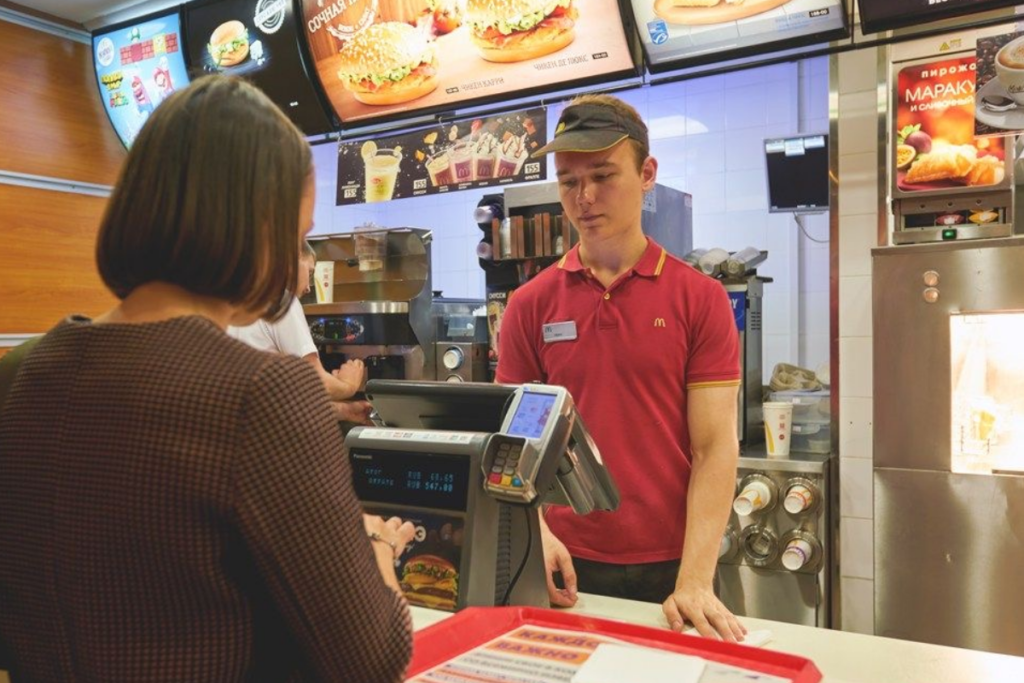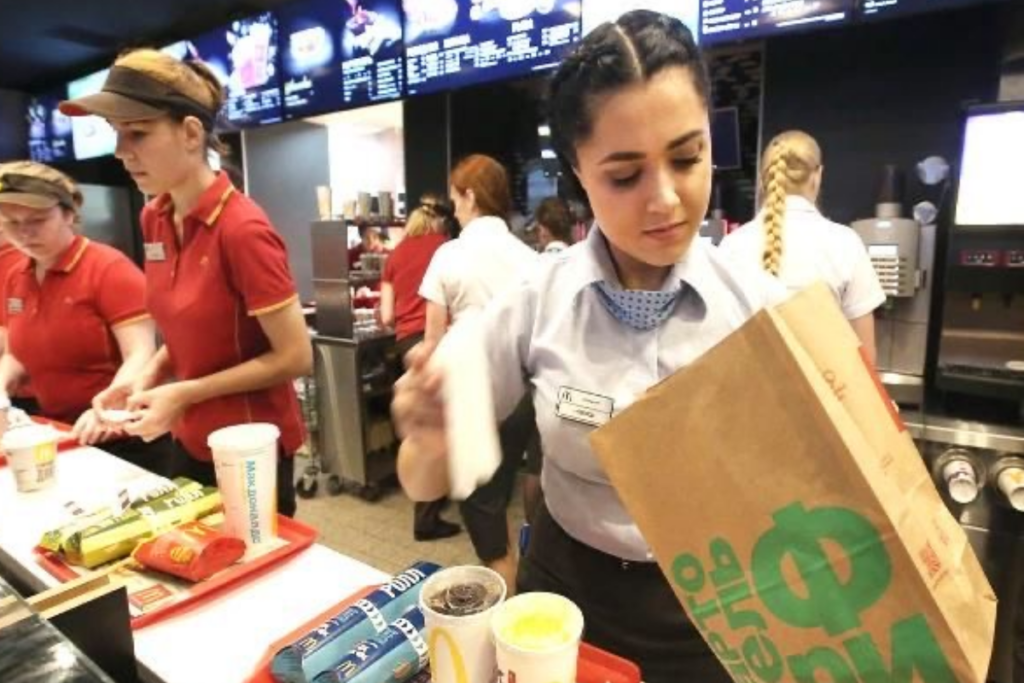Fast-food restaurants in California are saying they have to cut jobs. They are making this decision because of the new $20-an-hour minimum wage. Employees at Wendy’s, Pizza Hut, Del Taco, and Jersey Mike’s are getting fewer hours or days of work. The owners of these restaurants are also saying they have to reduce the hours their employees work. Many are even letting their workers go. One owner mentioned having to lay off 20 employees.
A Reduction in Fast Food Jobs
A report from the Associated Press says that a trade group made an alarming discovery. They announced that nearly 10,000 fast-food jobs have been lost in California since a new law started on April 1. However, unions disagree with these numbers.

Enif Somilleda has had a mixed experience with the law. As a manager at a Del Taco in Orange County, she has benefited from and been burned by this new law. Before, she had four employees working each shift, but now she only has two. “It has helped me financially,” she said. But I have fewer people, so I have to do a lot more work.”
Wendy’s Restaurant Owner Reduces Shift
Lawrence Cheng’s family owns seven Wendy’s restaurants south of Los Angeles, and he also had something to say. He told the Associated Press about the number of employees he used to have. He said that he used to have almost twelve employees working the afternoon shift at his Fountain Valley location in Orange County.

Now, he only schedules seven employees per shift. He does this because he struggles to handle the significant increase in labor costs. The hourly wage for fast food workers went up from $16 to $20, making it harder to afford as many workers.
Cutting Costs in Fast Food Restaurants
We cut costs wherever we can,” Cheng further stated. “I schedule one less person, and then I work the hour I didn’t schedule someone for.” Experts believe it’s too soon to determine the long-term effects of the wage increase on fast-food restaurants. They think it is uncertain if there will be many layoffs and closures in the future.

In the past, higher wages haven’t always caused job losses. For example, restaurants thrived when California and New York almost doubled their minimum wage to $15 an hour. The states made this change when the federal minimum wage was $7.25. According to a study from the University of California, Berkeley, jobs continued to grow.
ALSO READ: 10 Warning Signs to Watch Out for at Any Pizza Shop
Labour Union Vs. Restaurants
The labor union fighting for the raise and the restaurants against it are at odds again. Now, they’re arguing about the raise’s effects. Joseph Bryant, an executive from the Service Employees International Union (SEIU), made a statement. He said that the industry has created more jobs since the wage increase.

Bryant also mentioned that many franchise owners find that higher wages attract better job candidates, which means employees stay longer. On the other hand, many big fast-food chain owners say they must reduce workers’ hours and increase prices to keep their businesses running.
Effect of the New Law
A state trade group, the California Business and Industrial Alliance (CABIA), made a report. They reported that since the new law took effect on April 1, almost 10,000 jobs have been lost. Various restaurant chains like Pizza Hut and Burger King have lost this number of jobs. Also, many chains have been closing locations. For example, the Mexican restaurant chain Rubio’s Coastal Grill recently filed for Chapter 11 bankruptcy. The restaurant shut down 48 locations in California.

Juancarlos Chacon, owner of nine Jersey Mike’s locations in Los Angeles, expressed his opinion. He said, “I’ve been in the restaurant business for 25 years. I’ve been working with two different brands. And I can say that I have never had to raise prices as much as I did this past April.”
Increasing Food Prices
A turkey sub that used to cost less than $10 is now $11.15. Although customers are still coming in, it’s not the same. They are spending less by skipping drinks, chips, and desserts. Since most of the business happens at lunchtime, Chacon has reduced staff during the mornings and evenings. He also let go of some part-time employees, reducing the total number from 165 to 145.

Pay raises weren’t just for entry-level workers. Shift leaders, assistant managers, and everyone else also got raises. Labor costs now make up about 35% of his expenses. “I’m very nervous,” Chacon said.
A Great Divide Between Restaurants
Aaron Allen, the founder and CEO of a worldwide restaurant consulting company, mentioned something. He says he has received frantic calls from restaurant owners and suppliers in California. These people are still trying to bounce back from the COVID-19 lockdowns.

Allen believes an increasing gap will exist between giant companies like McDonald’s and smaller ones. He is convinced that there will be a great division between the two types of food corporations. Companies that invest in automation and save money by changing their menus will be separated from smaller, more local restaurant chains that might go out of business. These small businesses either do that or have to reduce the number of their locations significantly.
Pressure on Restaurants
Cheng mentioned that he doesn’t intend to fire any 250 Wendy’s employees. Instead, he has decided to reduce overtime hours and the number of workers per shift. He also increased menu prices by about 8 percent in January to cope with the new law. Despite these efforts, Cheng’s financial records indicate that he exceeded his budget by $20,000 for a two-week pay period.

Jot Condie, the president and CEO of the California Restaurant Association, made a statement. Condie, who opposed the minimum wage increase, said that businesses are being pressured by rising rent and facing problems with the cost of food.
ALSO READ: Walmart Shuts Down Stores Nationwide
Finding Solutions
“When the cost of labor increases by more than 25% suddenly, restaurants with already small profit margins will have to find a solution. They have to cut costs in other areas,” Condie said. “They don’t have many choices besides raising prices, reducing their hours, or cutting down their number of employees.”

Julieta Garcia gave her opinion from an employee’s point of view. Garcia, who has worked at Pizza Hut in Los Angeles for over a year, talked about her work hours. She mentioned that she now works five days a week instead of six. However, she doesn’t mind because it allows her to spend more time with her four-year-old son.
Minimum Wage Increase: A Good Thing for Workers
The extra money allows Garcia to pay her phone bill on time instead of having to turn it off. She can also take her son to the doctor to check his tonsils. Governor Gavin Newsom explained that raising the minimum wage was necessary to ensure that more than half a million fast-food workers in the state could earn a living wage.

Howard Lewis, a 63-year-old retiree working at a Wendy’s in Sacramento, said he has been using his extra money to invest. ‘Today was payday, and I bought $500 worth of stock,’ Lewis said. He is also helping his ex-wife by paying for her car’s brake repairs.”
You Might Also Like:
Inflation in the U.S. Falls by 0.1% With a Similar CPI Drop
Pfizer Continues Its Once-Daily Weight Loss Pill After Multiple Setbacks Last Year
Here’s the Wage You Need To Earn To Live Comfortably in US Cities
California’s $20 Minimum Wage Law Sparks Job Cuts in Restaurants
A Costly Cup of Chaos: Starbucks Charges Couple $4.5k For Coffee

